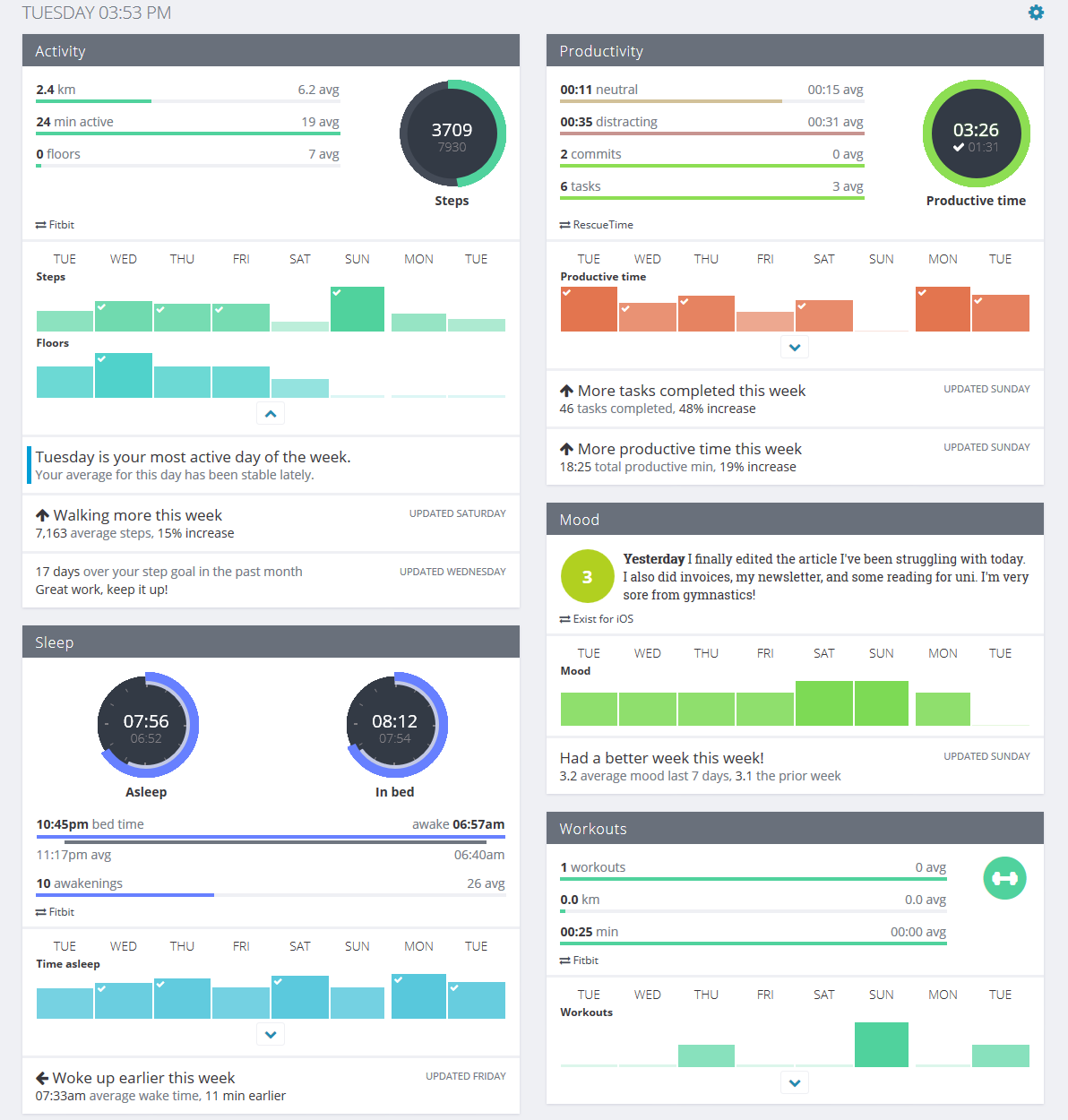23 Sep 2014
By Belle

Averages vs. goals
You might have noticed we made some big changes to your Exist dashboard lately. We redesigned the dashboard graphs and insights, which will hopefully make it easier to understand your data.

One change we made to the way your dashboard works is that we got rid of goals. You'll no longer see the goal you've set for your fitness tracker on your dashboard graphs. Instead, you'll now see your average for this day of the week (if it's Tuesday today, you'll see the average number of steps you take on Tuesdays). We did this because we believe averages make more sense than static goals.
The problems with goals
When you have a goal to hit 10,000 steps per day (the most common goal among fitness trackers), your results are binary: you either reach your goal or you don't. Anything less than 10,000 steps equals failure, even if you come really close. If your tracker was a person, it might say, "Oooh you almost made it! Nice one!" but instead it simply reminds you of the deficit between your results and your goal. There's no celebrating unless you hit that magical number. This is mostly due to the way fitness tracking software is designed, but since that's what most people rely on to get feedback about their progress towards their goal, it doesn't matter if the software doesn't reflect real life.
So each day your goal is reset. Whether you reached it yesterday or not is irrelevant; today you start again from zero.
This means you get no special credit or reward for having an exceptional day. If you do 18,000 steps in one day, which is nearly double your goal, you might get a notification from your fitness tracking app that congratulates you, but little else. And when tomorrow rolls around, your impressive feat is forgotten.
The Garmin Vivofit is one of the few trackers I know of that takes into account your actual activity levels. The Vivofit changes your goal depending on your activity, which sounds useful in theory but doesn't actually make much sense. Just because you walked 18,000 steps yesterday doesn't necessarily mean you'll walk a lot today as well. You may walk even fewer steps today if you're tired from all that exercising yesterday. Increasing your goal day by day doesn't reflect real-life activities.
And most fitness trackers don't even take into account your activity levels. They simply let you set (or set for you, in some cases) a static goal.
Why we're using averages instead
We're using averages in Exist in place of activity goals because we believe this is a better approach and it fits into our ethos of focusing on tiny improvements over time.
When you beat your average, it goes up a tiny bit. Over time, beating your average again and again means it will keep increasing, so you'll have a higher goal to aim for. Similarly, if you're struggling to meet your average, over time it will decrease until it's achievable again. There's no effort on our part to make this happen, it's simply how averages work. But it makes much more sense for users. Your activity goals are always going to be inline with your own habits and activity levels.
This also means anomalies get balanced out. If you have an 18,000-step day, your average will increase a little, but not a lot. You'll need to have lots of 18,000-step days to make a big impact on your average. So you get the reward of beating your average and seeing it increase a little, without being faced with an unattainable 18,000-step goal to aim for every day afterwards.
And each day your average will reflect how active you are on that day of the week. If you tend to exercise more on Wednesdays, your Wednesday average will be higher than other days. If you're more active on the weekend, you'll have a higher average to beat than on workdays. Averages reflect the habits you already have.
And each day you're competing against yourself. The goal you see when you login to Exist is the average of your steps. It's an average of your activity in the past, so if you beat it, you know you're improving without needing to look at extra stats like how many times you've hit your goal in the past month (though we do tell you that as well).
Lastly, using averages as goals means you can focus on small, achievable improvements. You don't need to worry about fitting 10,000 steps into your day if you're only used to doing 3,000. If your average is 3,000, then just 3,200 is an improvement. And who can't do an extra 200 steps?
We've taken away the gap between where you are now and 10,000 steps, or whatever your goal is. Instead, we're showing you how many steps you normally get on this day of the week, and how today compares to that average. We hope this will encourage you to focus on small improvements in your own habits, rather than worrying about reaching arbitrary goals.
If you're not sure which fitness tracker to buy, we've collected a whole bunch of fitness tracker reviews to help you decide. We recommend Fitbit models, but we also integrate with the Jawbone UP, Moves app, and Withings Pulse.
Exist helps you improve what matters to you. Sign up for an account to track and understand your life.
Subscribe Keep up to date with the Exist blog. Delivered to your inbox.